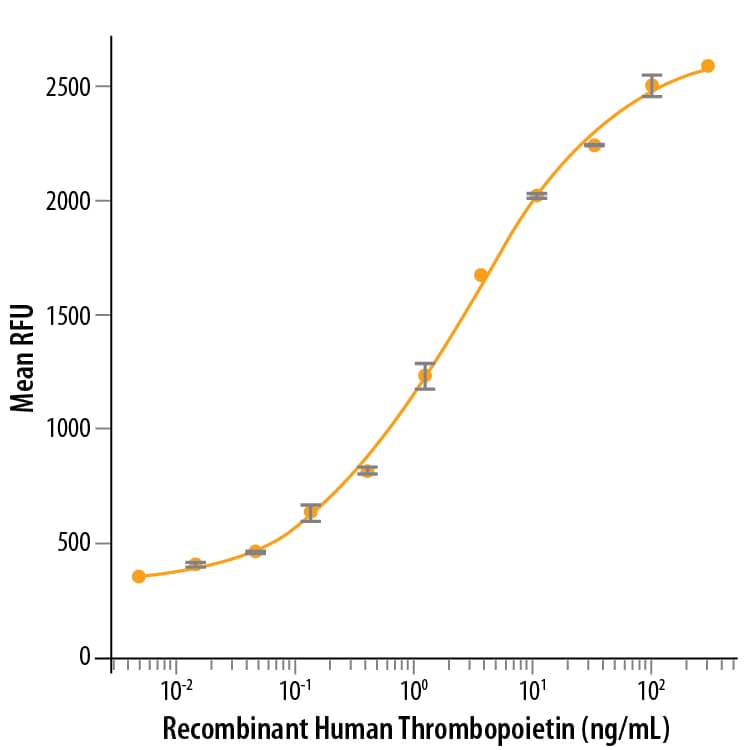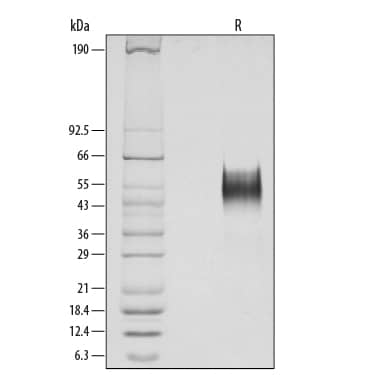Recombinant Human Thrombopoietin Protein Best Seller
R&D Systems, part of Bio-Techne | Catalog # 288-TP


Please see our Next Generation Human Recombinant Thrombopoietin (Catalog # 288-TPH). It combines R&D Systems quality with scalability that allows for lower price points and a solid supply chain.
Key Product Details
Product Specifications
Source
Ser22-Gly353
Purity
Endotoxin Level
N-terminal Sequence Analysis
Predicted Molecular Mass
SDS-PAGE
Activity
The ED50 for this effect is 0.3-3 ng/mL.
Scientific Data Images for Recombinant Human Thrombopoietin Protein
Recombinant Human Thrombopoietin Protein Bioactivity
Recombinant Human Thrombopoietin/Tpo (Catalog # 288-TP) stimulates proliferation in the MO7e human megakaryocytic leukemic cell line. The ED50 for this effect is 0.3-3 ng/mL.Recombinant Human Thrombopoietin Protein SDS-PAGE
1 µg/lane of Recombinant Human Thrombopoietin was resolved with SDS-PAGE under reducing (R) conditions and visualized by silver staining, showing major bands at 43-60 kDa. Multiple bands in gel are due to variable glycosylation.Formulation, Preparation and Storage
Carrier Free
What does CF mean?CF stands for Carrier Free (CF). We typically add Bovine Serum Albumin (BSA) as a carrier protein to our recombinant proteins. Adding a carrier protein enhances protein stability, increases shelf-life, and allows the recombinant protein to be stored at a more dilute concentration. The carrier free version does not contain BSA.
What formulation is right for me?In general, we advise purchasing the recombinant protein with BSA for use in cell or tissue culture, or as an ELISA standard. In contrast, the carrier free protein is recommended for applications, in which the presence of BSA could interfere.
Carrier: 288-TP
| Formulation | Lyophilized from a 0.2 μm filtered solution in Acetonitrile and TFA with BSA as a carrier protein. |
| Reconstitution | Reconstitute at 50-200 μg/mL in sterile 4 mM HCl containing at least 0.1% human or bovine serum albumin. |
| Shipping | The product is shipped at ambient temperature. Upon receipt, store it immediately at the temperature recommended below. |
| Stability & Storage | Use a manual defrost freezer and avoid repeated freeze-thaw cycles.
|
Carrier Free: 288-TP/CF
| Formulation | Lyophilized from a 0.2 μm filtered solution in Acetonitrile and TFA. |
| Reconstitution | Reconstitute at 50-200 µg/mL in sterile 4 mM HCl. |
| Shipping | The product is shipped at ambient temperature. Upon receipt, store it immediately at the temperature recommended below. |
| Stability & Storage | Use a manual defrost freezer and avoid repeated freeze-thaw cycles.
|
Background: Thrombopoietin/Tpo
Thrombopoietin (Tpo), is a key regulator of megakaryocytopoiesis and thrombopoiesis. It is principally produced in the liver and is bound and internalized by the receptor Tpo R/c‑mpl. Defects in the Tpo‑Tpo R signaling pathway are associated with a variety of platelet disorders (1‑3). The 353 amino acid (aa) human Tpo precursor is cleaved to yield the 332 aa mature protein. Mature human Tpo shares approximately 70% aa sequence homology with mouse and rat Tpo. It is an 80‑85 kDa protein that consists of an N‑terminal domain with homology to Erythropoietin (Epo) and a C‑terminal domain that contains multiple N‑linked and O‑linked glycosylation sites (4, 5). Tissue specific alternate splicing of human Tpo generates multiple isoforms with internal deletions, insertions, and/or C‑terminal substitutions (6). Tpo promotes the differentiation, proliferation, and maturation of MK and their progenitors (4, 5, 7). Several other cytokines can promote these functions as well but only in cooperation with Tpo (8, 9). Notably, IL‑3 independently induces MK development, although its effects are restricted to early in the MK lineage (8, 9). Tpo additionally promotes platelet production, aggregation, ECM adhesion, and activation (10, 13). It is cleaved by platelet‑derived thrombin following Arg191 within the C‑terminal domain and subsequently at other sites upon extended digestion (14). Full length Tpo and shorter forms circulate in the plasma (4, 5). The C‑terminal domain is not required for binding to Tpo R or inducing MK growth and differentiation (5). Aside from its hematopoietic effects, Tpo is expressed in the brain where it promotes the apoptosis of hypoxia‑sensitized neurons and inhibits neuronal differentiation by blocking NGF induced signaling (15, 16).
References
- Deutsch, V.R. and A. Tomer (2006) Br. J. Haematol. 134:453.
- Kaushansky, K. (2005) J. Clin. Invest. 115:3339.
- Li, J. et al. (1999) Br. J. Haematol. 106:345.
- Bartley, T.D. et al. (1994) Cell 77:1117.
- de Sauvage, F.J. et al. (1994) Nature 369:533.
- Marcucci, R. and M. Romano (2008) Biochim. Biophys. Acta 1782:427.
- Kaushansky, K. et al. (1994) Nature 369:568.
- Kaushansky, K. et al. (1995) Proc. Natl. Acad. Sci. 92:3234.
- Broudy, V.C. et al. (1995), Blood 85:1719.
- Lok, S.I. et al. (1994) Nature 369:565.
- Chen, J. et al. (1995) Blood 86:4054.
- Oda, A. et al. (1996) Blood 87:4664.
- Van Os, E. et al. (2003) Br. J. Haematol. 121:482.
- Kato, T. et al. (1997) Proc. Natl. Acad. Sci. 94:4669.
- Ehrenreich, H. et al. (2005) Proc. Natl. Acad. Sci. 102:862.
- Samoylenko, A. et al. (2008) Cell. Signal. 20:154.
Alternate Names
Gene Symbol
UniProt
Additional Thrombopoietin/Tpo Products
Product Documents for Recombinant Human Thrombopoietin Protein
Product Specific Notices for Recombinant Human Thrombopoietin Protein
For research use only
